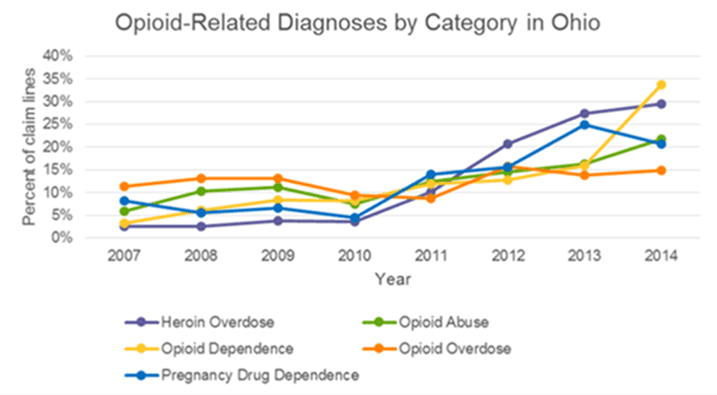From 2007 to 2014, private insurance claim lines with opioid-related diagnoses increased 770 percent in Ohio. The diagnoses were opioid abuse, opioid dependence, heroin overdose and overdose of opioids excluding heroin. Of five of the major cities in the state — Cincinnati, Cleveland, Columbus, Dayton and Toledo — Toledo had the largest increase, at 1,022 percent.
In this article, we report the findings in terms of “claim lines,” which are the individual services or procedures listed on an insurance claim. “Percent of claim lines” is the percent of all claim lines associated with a specific group of diagnosis codes in a defined time period.
The increase in claim lines with opioid-related diagnoses is vividly illustrated in this accompanying table. The increase for Ohio was 770 percent for the entire period from 2007 to 2014, but only 171 percent from 2011 to 2014.

Distribution of Claim Lines with Opioid-Related Diagnoses
Here, the five studied cities make up 62 percent of the distribution, with the rest of Ohio making up only 38 percent.

There are several possible reasons for the cities’ disproportionate share of private insurance claim lines with opioid-related diagnoses. It could be that Medicaid use is higher in the rest of Ohio than in the five studied cities, there are more people with private insurance in the five cities than in the rest of Ohio, or there is more access to opioids in the five cities than in the rest of Ohio.
Opioid-Related Diagnoses by Category
In Ohio, from 2007 to 2014, there were increases in — heroin overdose, overdose of opioids excluding heroin, opioid abuse, opioid dependence and pregnancy drug dependence. But, the largest increase occurred with heroin overdose (1,078 percent), followed closely by opioid dependence (947 percent).

Overdoses by Age and Gender
In Ohio in the period 2007-2014, heroin overdoses showed strikingly different age-related patterns compared to overdoses of opioids excluding heroin. Claim lines associated with heroin overdose occurred overwhelmingly in 19-to 30-year-olds. By contrast, claim lines associated with opioid overdose excluding heroin occurred more frequently in the over-30 age groups.
In the age group 18 years and under, claim lines with such an opioid overdose occurred more frequently in males than females. In the 19 to 30 year age group, the genders were about equally distributed (52 percent female and 48 percent male). After 30 years old, women were more likely to be diagnosed with an opioid overdose than men. In the over 50 age group, 73 percent of the claim lines with an opioid overdose diagnosis were for women and only 27 percent for men.
As the opioid epidemic continues to spread, robust, reliable data will remain vital to understanding the complexities and layered impact of this pressing national issue.


























